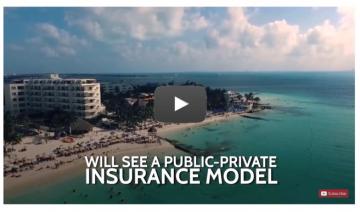This is the second blog in a series leading up to the 2020 WEF Annual Meeting, which is focused on “Stakeholders for a Cohesive and Sustainable World”
The majority of financing required to achieve the sustainable development goals (SDGs) is anticipated to come from the private sector, with an estimated US$12 trillion in opportunities for business by 2030. To ensure that these investments yield both a financial return and a return for nature, collaboration is needed across the insurance, investment, and banking sectors. Already, thousands of financial institutions are aligning their portfolios with the SDGs, including the more than 2,000 signatories to the UN Principles for Responsible Investment (PRI) that represent more than US$80 trillion in assets in more than 50 countries. In addition, there has been significant growth in recent years in a variety of green financial products, including green bonds, green loans, green sukuk, green securitisation, equity finance, impact investing, and climate risk insurance. Since the first green bond was issued in 2007, they have raised more than US$750 billion, with issuance in 2019 alone reaching nearly US$250 billion.
However, the connection with developments on the ground continues to be challenging. Below, we feature some of our latest resources and case studies that illustrate how the insurance, investment, and banking industries are engaging in multi-stakeholder collaboration to sustainably manage natural capital.
Developing insurance products to mitigate risks to natural capital
Too often, the insurance industry’s value proposition is limited to that of a risk carrier (i.e. paying for financial losses incurred by clients). However, the insurance industry has a wealth of experience in reducing risks and preventing and losses through, for instance, pollution prevention, flood resilience, and fire safety. With more than US$30 trillion in global assets under management, the insurance industry is a major institutional investor. Responding to this, the first-ever global insurance industry guide was published in 2019. It provides practical tools and recommendations while highlighting innovative approaches to public-private collaboration for the protection of World Heritage:
- In Mexico, the state government of Quintana Roo announced the creation of a “Coastal Zone Management Trust” in 2018 to promote the conservation of coastal areas. It is financing insurance coverage for the Mesoamerican coral reef and coastal beach sand against the impact of hurricanes. Swiss Re supported the development of this innovative insurance product and, in 2019, the government purchased a parametric insurance policy that would offer up to US$3.8 million to repair hurricane damage to the reef.
Increasing investments in natural capital through blended finance
Blended finance is a key tool for mobilisation of commercial capital and offers an opportunity to move towards fully market-based financing in support of the SDGs. In addition to traditional uses of blended finance where the public sector incentivises private financing, new forms of blended finance are now emerging. Recent research on Ecosystem-based Adaptation (EbA) recommends a combination of public and private financing instruments to ensure the coverage of both investment costs (infrastructure, capacity, technology) and operating costs (coordination, facilitation). Examples include:
- The eco.business Fund is a public-private partnership (PPP) that provides green financing and technical assistance to financial institutions and businesses committed to environmental practices in Latin America and sub-Saharan Africa. The Fund invests in projects in agriculture, fisheries, forestry, and ecotourism whereby public investments help soften the risks that might prevent the participation of private investors. As such, it allows for financial support of EbA measures by business owners that want to limit their environmental impact and adapt their practices to a changing climate.
- The Althelia Climate Fund and Sustainable Ocean Fund have adopted a blended finance approach to natural capital investment, which is based on using concessional funding or loan guarantees from public institutions to attract mainstream investors. Through this approach, Althelia helps farmers and fishing communities develop additional sources of revenue from natural capital, such as carbon credits from forest restoration, the provision of clean water, sustainable fisheries, and crop pollination. The newest addition to its portfolio is the Sumatra Merang Peatland project, which was launched in 2017, scaled up with an impact investment of EUR 5.1 million in 2018, and received verification by VCS and CCB in 2019.
Aligning commercial bank lending to the SDGs and countries’ NDCs
As countries seek to implement and, ideally, increase the ambition of their Nationally Determined Contributions (NDCs) under the Paris Agreement, there is an opportunity for financial institutions to take action. Several recent case studies show that commercial banks are already stepping up to offer innovative financial products that help countries to achieve their NDCs and the SDGs. Examples include:
- In Mongolia, XacBank has aligned with the national SDG and NDC targets to supply at least 30 percent of the country’s energy through renewables by 2030. In 2016, XacBank became the first commercial bank from a developing nation to achieve National Implementing Entity accreditation for the Green Climate Fund (GCF). It has been developing a portfolio of climate finance products mapped to the SDGs, including a loan program with preferential rates for greenhouse gas reduction projects by SMEs, a renewable energy loan facility for utility-scale solar power projects, and an energy efficiency loan program for residential and commercial clients.
- In Spain, financial services company BBVA launched a climate change and sustainable development strategy called the “Pledge 2025.” BBVA aims to increase its support and that of the financial industry for sustainable development and the management of environmental and social risks. For the SDGs, BBVA presents both current and targeted exposure to 2025. The company has aligned itself with the TCFD recommendations, UN PRI, UN Global Compact, and RE 100.
TAKE ACTION
- ENGAGE with our Expert Working Group on Natural Capital
- DISCOVER What’s New: Stay up to date on the latest knowledge via Twitter, LinkedIn, Facebook, and GGKP's Knowledge Update Newsletter
ADDITIONAL READING
The opinions expressed herein are solely those of the authors and do not necessarily reflect the official views of the GGKP or its Partners.






